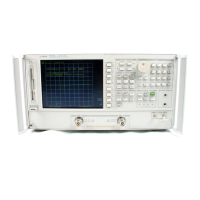Data Levels
Different levels of data can be read out of the instrument. Refer to the
data-processing chain in Figure
l-4.
The following list describes the
different types of data that are available from the network analyzer.
Pre-raw data This is the raw data without sampler
correction or attenuator offsets
applied. With raw offsets turned off,
the calibration coefficients generated
can be transferred to an external
controller and used with the data
gathered using the
OUTPPRE[
l-41
commands. Refer to “Example
2E:
‘lake4
-
Error Correction Processed
on an External Computer,” located in
HP BASIC Programming Examples
Guide. If a 2-port measurement
calibration is active, or
Take4
mode is
on, the four arrays refer to
S11,
Sal,
S12,
and
Ssz
respectively. This data is
represented in real/imaginary pairs.
Raw data
Error coefficients
The basic measurement data,
reflecting the stimulus parameters, IF
averaging, and IF bandwidth. If a
full Z-port measurement calibration
is activated, there are actually
four raw arrays kept: one for each
raw S-parameter. The data can be
output to a controller with the
commands OUTPRAW 1,
OUTPRAWB
,
OUTPRAW3,OUTPRAW4.
Normally,
only raw 1 is available, and it holds
the current parameter. If a 2-port
measurement calibration is active,
the four arrays refer to
S11,
S21,
S12,
and &a respectively. This data is
represented in real/imaginary pairs.
The results of a measurement
calibration are arrays containing
error coefficients. These error
coefficients are then used in the
error-correction routines. Each array
corresponds to a specific error term
l-40
HP-IB
Programnu
‘ng and Command Reference Guide

